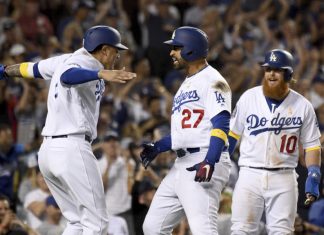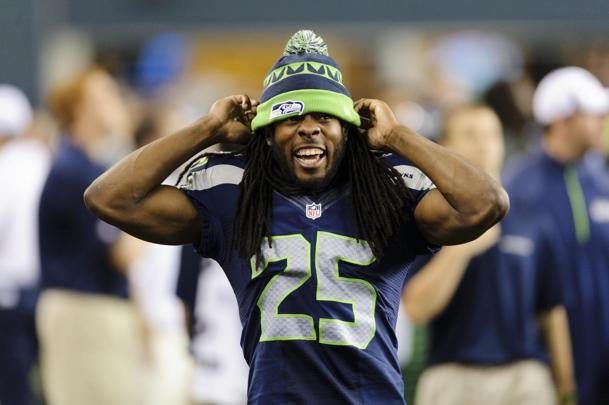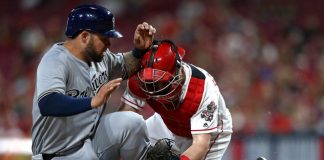They play in an architectural nightmare of a ballpark.
They are treated like pariahs in their own community.
They have to get by with one of baseball’s stingiest payrolls.
Yet, somehow, the Tampa Bay Rays make it work.
It’s one of the most compelling stories in sports, even if few people take notice.
”Whatever you want to label us, it’s honestly irrelevant,” outfielder Kevin Kiermaier said. ”We know we’re good and we can go a long way with the guys we have here.”
The Rays went into a weekend series against the mighty New York Yankees leading the AL East by a half-game. Never mind that Tampa Bay started the year with a penny-pinching payroll of just $60.6 million – $10 million less than the 29th-lowest team (a Miami Marlins team headed toward a historically awful season) and barely a fourth of what the reigning World Series champion Boston Red Sox doled out to assemble the most expensive roster.
To add a bit more perspective, Bryce Harper will take home $30 million this year after signing a record-breaking deal with the Philadelphia Phillies.
The Rays put together a whole team for about twice that amount.
When the Rays (and their West Coast soul mates, the Oakland Athletics) have a hole to fill, they can’t just throw money at it like the big-market teams. They have to maintain a never-ending cycle of prescient drafts (AL Cy Young winner Blake Snell was a first-round pick in 2011), wily trades (Austin Meadows and Tyler Glasnow are top young players acquired from the Pirates) and scouring free agency for the occasional bargain (15-game winner Charlie Morton took a two-year contract that didn’t break the bank).
Stability is not something the Rays can afford, so the roster is turning over constantly. Kiermaier is the only player on the current 25-man squad who was with Tampa Bay before 2017.
Also required: thinking outside the box, which led to the Rays to the idea of starting the game with an ”opener” – a reliever who works just the first inning or two before turning the game over to other relievers, allowing the team to shorten its rotation, maximize its bullpen and create matchup problems for opposing lineups.
”They maximize their roster and they use their roster very uniquely,” said manager A.J. Hinch of the Houston Astros, another big-payroll team.
Since their breakthrough 2008 season, when the Rays posted the first winning record in franchise history and made it all the way to the World Series, they have bucked the odds to stay competitive – even while playing alongside the Red Sox and Yankees in one of baseball’s toughest divisions.
Tampa Bay has five 90-win campaigns, three playoff appearances and only one really awful season over the past decade. They seemed to be fading just a bit after losing wunderkind general manager Andrew Friedman to the Los Angeles Dodgers and longtime manager Joe Maddon to the Chicago Cubs, only to bounce back last season with a 90-72 mark.
Thirty-six-year-old general manager Erik Neander, a numbers-savvy graduate of Virginia Tech who didn’t have any experience as a player or coach when he joined the Rays’ front office, picked up where Friedman left off. Kevin Cash was only 37 when he replaced Maddon but quickly developed into one of baseball’s most-respected managers.
Like those who came before them, there’s a real good chance Neander and Cash will find themselves fielding offers from better-funded teams in the very near future. But, for now, they’re enjoying the challenge of making sure the Rays don’t just survive, but thrive.
”There’s no doubt baseball has done one thing for many consecutive years kind of one way,” Cash said, relishing the chance to shake things up with innovations like the opener.
Playing in desolate Tropicana Field, a 1980s relic that essentially epitomizes everything that can go wrong when designing a ballpark (catwalks, anyone?), the Rays have pushed for more than a decade to build a spiffy new home.
No luck.
While the Rays lead the big leagues in fancy stadium drawings, they’ve never managed to turn one spade of dirt. A proposed new facility along the St. Petersburg waterfront, complete with a retractable roof that resembled a giant sail, sank a decade ago. Just last December. The team abruptly called off its plan to build a tiny new home on the other side of the bay, after pitching a 30,000-seat stadium with sliding glass walls and a translucent roof in the historic Ybor City neighborhood of Tampa.
For now, the Rays’ big stadium move was closing off the entire upper deck at Tropicana Field, reducing the official capacity to around 25,000 in a facility that can hold up to 45,000. They certainly don’t need all those seats, having drawn a paltry 14,540 per game despite a 26-15 start.
Only the Marlins attract fewer fans, but they’ve worked hard to drive crowds away.
The Rays deserve far better support than they’ve received from the Tampa Bay area, ranking last or next-to-last in attendance for eight straight seasons. Major League Baseball should probably be pushing to find this franchise a new home (Montreal? Portland? Anywhere?), especially since the Ybor City project fell through.
In the meantime, the Rays just go about their business.
Let others have massive payrolls, and fancy ballparks, and rabid fan support.
None are required for this remarkably resilient franchise.
—
Paul Newberry is a sports columnist for The Associated Press. Write to him at pnewberry(at)ap.org or at www.twitter.com/pnewberry1963 His work can be found at https://apnews.com/search/paul%20newberry
—
For more AP baseball coverage: https://apnews.com/apf-Baseball and https://twitter.com/AP-Sports
—
AP Sports freelancers Mark Didtler and Dick Scanlon contributed to this report.
25% Bonus via Western Union













